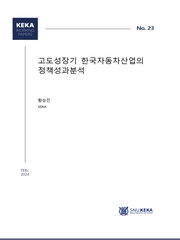
Policy Performance Analysis of Korea's High-growth Automobile Industry |
|
AbstractKEKA Working Papers No. 23 This paper utilizes eight rounds of industry association tables published by the Bank of Korea from 1960 to 1980 to analyze the performance of Korea’s automobile industry policy during its high-growth period and derive coefficients of production induction and sensitivity. These estimates were then compared to the pre- and post-policy periods before the implementation of the Heavy Chemicals Industrial Policy in 1973 by analyzing the growth rates of each coefficient in the 1966–1973 period and the 1973–1980 period. We utilized the DID method to analyze the differences in the estimates of the coefficients of production induced by the automobile industry, the heavy chemical industry, the light industry, which was an export support industry in the 1960s, and the service industry, which was ineligible for the policy. The analysis shows that the automobile industry has grown at a higher rate than the light industry in all sectors in 1973, including total output (130.5 %p), production induced coefficient (34.6 %p), value-added induced coefficient (40.65 %p), and sensitivity coefficient (29.9 %p). The Park Chung-hee administration's automobile industry policy created an asymmetric environment that favored domestic junior firms, attracting them to make bold investments. The government made an efficient choice that ultimately succeeded in catching up by pursuing shared growth by increasing the small-and-medium-sized parts companies’ use of domestic intermediate goods.
|
FilesKEKA Working Paper_No.23.pdf (463 KB)
|

